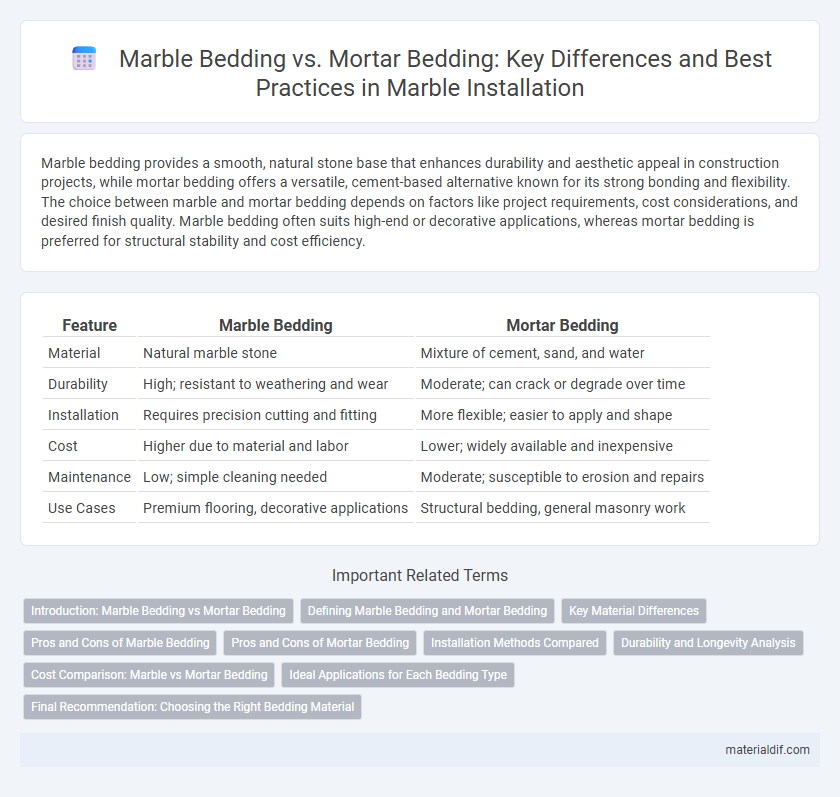Marble bedding provides a smooth, natural stone base that enhances durability and aesthetic appeal in construction projects, while mortar bedding offers a versatile, cement-based alternative known for its strong bonding and flexibility. The choice between marble and mortar bedding depends on factors like project requirements, cost considerations, and desired finish quality. Marble bedding often suits high-end or decorative applications, whereas mortar bedding is preferred for structural stability and cost efficiency.
Table of Comparison
| Feature | Marble Bedding | Mortar Bedding |
|---|---|---|
| Material | Natural marble stone | Mixture of cement, sand, and water |
| Durability | High; resistant to weathering and wear | Moderate; can crack or degrade over time |
| Installation | Requires precision cutting and fitting | More flexible; easier to apply and shape |
| Cost | Higher due to material and labor | Lower; widely available and inexpensive |
| Maintenance | Low; simple cleaning needed | Moderate; susceptible to erosion and repairs |
| Use Cases | Premium flooring, decorative applications | Structural bedding, general masonry work |
Introduction: Marble Bedding vs Mortar Bedding
Marble bedding involves setting marble slabs on a thin, even layer of adhesive or bedding compound to ensure a smooth, level surface with enhanced stability and aesthetic appeal. Mortar bedding uses a mixture of cement, sand, and water, forming a thick bed that provides strong support but may be less precise for delicate marble installations. Choosing between marble bedding and mortar bedding depends on the desired finish, structural requirements, and the type of marble used in the project.
Defining Marble Bedding and Mortar Bedding
Marble bedding refers to the technique of setting marble slabs on a smooth layer of marble dust or a similar fine material, ensuring a precisely level and stable base, ideal for high-precision marble installations. Mortar bedding involves laying marble slabs on a mixture of cement, sand, and water, forming a strong adhesive foundation that accommodates slight surface irregularities and enhances structural integrity. Both methods are crucial in marble construction for achieving durability and aesthetic quality, with marble bedding favored for refinement and mortar bedding preferred for robust support.
Key Material Differences
Marble bedding involves setting marble slabs on a thin layer of adhesive or cement-based mortar, providing strong support while allowing slight flexibility and minimizing cracking. Mortar bedding, on the other hand, uses a thicker mortar layer, which offers enhanced stability and load distribution but may be less forgiving to natural stone movement. The primary material difference lies in the application thickness and flexibility of the bedding medium, impacting the durability and appearance of the marble installation.
Pros and Cons of Marble Bedding
Marble bedding offers superior aesthetic appeal and durability, enhancing the elegance and longevity of stone installations in architectural projects. Its natural strength and polished finish provide excellent resistance to weathering and stains compared to traditional mortar bedding. However, marble bedding can be more expensive and challenging to install due to its weight and the need for skilled labor, and it may be prone to chipping under heavy impact.
Pros and Cons of Mortar Bedding
Mortar bedding offers strong adhesion and durability for marble installations, ensuring secure placement and resistance to shifting or cracking under heavy loads. However, it can be labor-intensive and time-consuming to apply, requiring skilled workmanship for even surfaces and proper curing times. Moisture retention in mortar beds may lead to potential long-term issues like efflorescence or staining on marble surfaces if not properly sealed.
Installation Methods Compared
Marble bedding involves laying polished marble slabs on a bed of sand or adhesive, providing a smooth, level surface ideal for aesthetic appeal and precise alignment. Mortar bedding uses a mixture of cement, sand, and water to secure marble pieces, offering robust adhesion and enhanced durability for high-traffic areas. The choice between marble bedding and mortar bedding depends on factors such as installation environment, structural support, and maintenance requirements.
Durability and Longevity Analysis
Marble bedding offers superior durability compared to mortar bedding due to its natural strength and resistance to weathering and chemical erosion. Marble's dense crystalline structure ensures long-lasting stability in construction, minimizing the risk of cracking or degradation over time. Mortar bedding, while initially flexible, tends to weaken under prolonged exposure to moisture and temperature fluctuations, reducing its overall longevity.
Cost Comparison: Marble vs Mortar Bedding
Marble bedding typically incurs higher costs due to the premium price of natural stone and the skilled labor required for precise installation. Mortar bedding is generally more affordable, relying on a mixture of cement, sand, and water, which reduces material expenses and setup time. Choosing between marble and mortar bedding involves balancing aesthetic appeal and durability against budget constraints.
Ideal Applications for Each Bedding Type
Marble bedding involves setting marble slabs on a thin, even layer of mortar, providing a strong, level surface ideal for flooring and countertops in residential and commercial spaces where durability and aesthetics matter. Mortar bedding, using a thicker mortar bed, is preferred for uneven substrates or outdoor installations like patios and walkways, ensuring stability and proper drainage under marble tiles. Choosing between marble and mortar bedding depends on the project's structural requirements, surface conditions, and intended use to optimize longevity and appearance.
Final Recommendation: Choosing the Right Bedding Material
Marble bedding provides a durable, aesthetically pleasing foundation with excellent moisture resistance ideal for enhancing natural stone installations, while mortar bedding offers versatility and strong adhesion suitable for varied environmental conditions. For projects demanding precise stone alignment and longevity in high-traffic areas, marble bedding is preferable due to its refined finish and longevity. Selecting the right bedding material depends on project-specific factors such as environmental exposure, budget, and desired durability, with marble bedding favored for premium applications and mortar bedding for general, cost-effective solutions.
Marble Bedding vs Mortar Bedding Infographic

 materialdif.com
materialdif.com